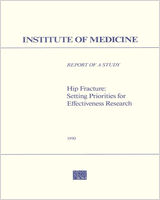NCBI Bookshelf. A service of the National Library of Medicine, National Institutes of Health.
Institute of Medicine (US) Division of Health Care Services; Heithoff KA, Lohr K, editors. Hip Fracture: Setting Priorities for Effectiveness Research. Washington (DC): National Academies Press (US); 1990.

Hip Fracture: Setting Priorities for Effectiveness Research.
Show detailsEffectiveness Initiative
In 1988, the Health Care Financing Administration (HCFA) of the U.S. Department of Health and Human Services (DHHS) proposed an Effectiveness Initiative, the purpose of which was to bring the resources of Medicare to bear on the question of what works in the practice of medicine. The objectives of the Effectiveness Initiative were, first, to assess the overall merit of competing health care interventions and, second, to provide information that would help clinicians in managing their patients, improve the peer review process (e.g., of the Medicare Peer Review Organizations [PROs]), and aid policymakers in allocating Medicare resources. HCFA also identified four activities to support these objectives: (1) monitoring time trends in the use of services by the Medicare population; (2) analyzing geographic (population-based) variations in the use of services and in outcomes of care; (3) assessing interventions by clinical demonstrations, observational studies, and randomized controlled trials (RCTs); and (4) feeding back information to clinicians in education programs.
Planning for effectiveness and outcomes research within DHHS in 1988 and 1989, and the recent transfer of effectiveness research to the Public Health Service, incorporates the above purposes and adds responsibility for the development of practice guidelines. Although this monograph reports on work conducted for the HCFA Effectiveness Initiative, it pertains to all effectiveness research supported by DHHS.
The IOM Clinical Workshop
In 1988, HCFA consulted widely with individuals and organizations in the medical, health financing, and health services and policy research communities for guidance on its program initiative. It then asked the Institute of Medicine (IOM), National Academy of Sciences, to recommend the clinical conditions that should receive priority attention. Conceptually, this reflected a decision to choose the clinical condition as the unit of analysis rather than specific procedures or technologies.
In October 1988, the IOM appointed a study committee and convened a ''clinical workshop." The clinical workshop committee recommended five clinical priorities; stable and unstable angina, acute myocardial infarction, breast cancer, congestive heart failure, and hip fracture.1 These five conditions met several selection criteria, including high prevalence, burden of the illness on elderly people, appreciable variations in the use of services and in outcomes, high costs, and controversy about alternative ways to manage patients that reflects professional uncertainty.
Hip fracture was recommended for several other reasons. It is almost exclusively a disease of elderly people, there is little clinical disagreement about diagnosis, and the acute phase is universally treated in hospitals. Disagreement exists about certain aspects of the treatment: length of hospital stay, surgical options (pinning, replacing the femoral head, total hip replacement), and timing of surgical interventions; and about etiology and prevention. Issues of long term care and of long-run functional outcomes are also very important.
Condition-Specific Research Workshops
Purpose
After the clinical workshop, HCFA asked the IOM to conduct condition-specific workshops for three high-priority clinical areas: breast cancer, acute myocardial infarction, and hip fracture. These workshops had three objectives: (1) to examine each clinical condition in detail; (2) to identify central topics within each condition deserving further investigation in terms of "effectiveness" as contrasted with "efficacy"; and (3) to propose appropriate research strategies and methods.
The distinction between effectiveness and efficacy is especially important. Efficacy typically means the outcome of an intervention when it is applied in "ideal," well-controlled circumstances, such as those inherent in prospective randomized controlled trials. Outcomes of interest may be quite technical and oriented to physiologic variables and survival. By contrast, effectiveness concerns the outcome of an intervention realized when it is applied in "everyday" or "average" circumstances (such as the daily practice of medicine); these situations may involve patient subgroups that differ considerably from those studied in RCTs. Outcomes, moreover, may embrace broader quality of life concerns, such as physical and social functioning and emotional well-being.
Research Workshop Committee
For the condition-specific research workshops, the IOM appointed a "core committee" of clinicians and researchers in 1989; it was chaired by Kenneth I. Shine, M.D., Dean of the School of Medicine, University of California, Los Angeles.2 For each workshop, the core committee was augmented with clinicians and researchers with recognized expertise in the condition of interest.
Committee Charge
The hip fracture committee was charged with two responsibilities: (1) to recommend to the HCFA administrator a small number of issues in hip fracture patient management for the elderly population that should receive priority in the Effectiveness Initiative; and (2) to suggest specific research strategies to be employed by HCFA and other public and private research organizations that address these issues. Secondary questions were how the present or proposed Medicare databases might be used to further this research, what should be added to the current databases, and what studies must be conducted independently of the HCFA databases.
This monograph reports on the hip fracture workshop, presents background information on clinical aspects of hip fracture, and summarizes the committee's deliberations, findings, and recommendations. The appendix documents the study and workshop activities.
Footnotes
- 1
The 1988 clinical workshop committee also recommended a second tier of clinical conditions that could receive later attention: cataracts, depressive disorders, prostatic hypertrophy, and transient ischemic attacks with or without occlusion. The report of this study was published as Effectiveness Initiative: Setting Priorities for Clinical Conditions in April 1989; it is available from the Institute of Medicine (Report No. IOM-89-04).
- 2
Five members of the core committee had also been members of the clinical workshop committee (Drs. Shine, Murray, Nelson, Smith, and Sox), and three are new (Drs. Henderson, Keeler, and Schwartz).
- Introduction - Hip Fracture: Setting Priorities for Effectiveness ResearchIntroduction - Hip Fracture: Setting Priorities for Effectiveness Research
Your browsing activity is empty.
Activity recording is turned off.
See more...